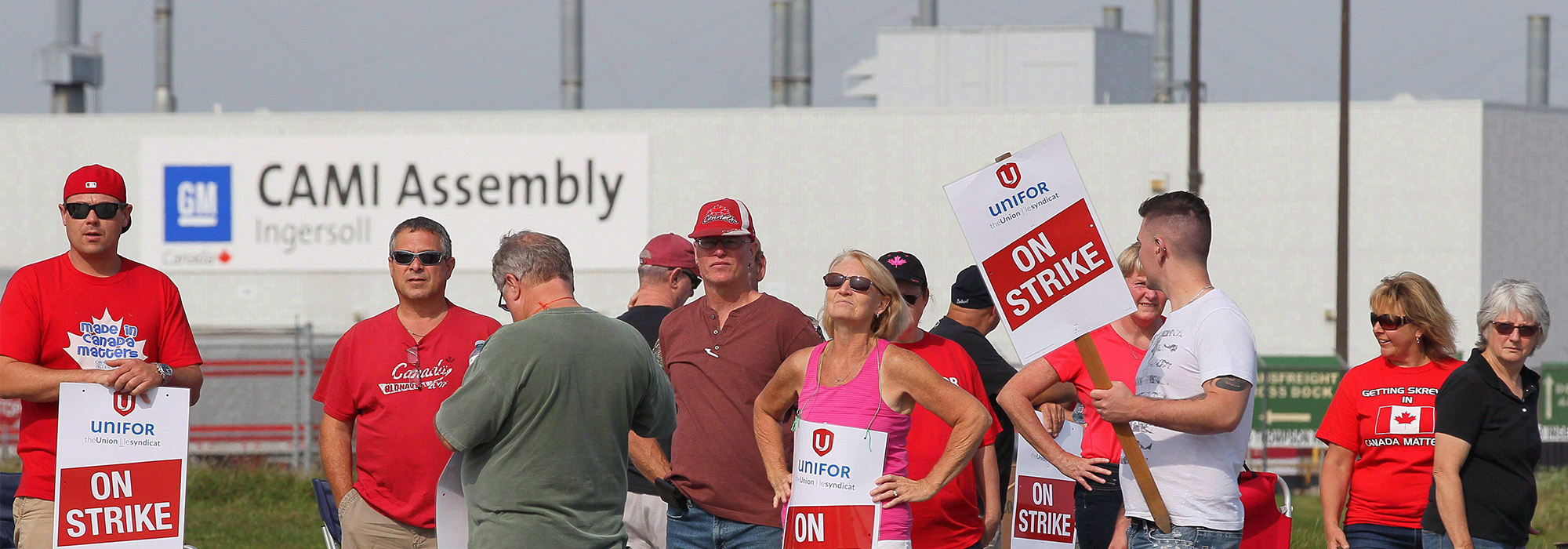
There’s more to the recent split between the Canadian Labour Congress (CLC) and Unifor than meets the eye. On the surface, the dispute that led Canada’s largest private sector union to withdraw in January from Canada’s largest union confederation is either about an independent Canadian union standing up to American union bullies (if you believe Unifor, which says that some CLC unions are controlled by American interests) or a big Canadian union using its weight to break labour solidarity by stealing another union’s members (if you believe the CLC).
But beneath this public airing of grievances is a bigger debate about the future of the labour movement, highlighting differing visions within the union movement about solidarity and how it is produced and maintained.
One side argues that we need to consider highly localized workers’ desires and choices, and whether these workers can hold their union accountable for their immediate interests. The other side insists the labour movement needs to maintain and prioritize a unified front, even if it means accountability must be exercised indirectly through administrative union processes overseen and exercised by those at least two steps removed from the collective bargaining process.
Unifor is arguing that accountability should be exercised directly by the members themselves, and that the process for dealing with disputes between unions outlined in the CLC’s constitution is onerous, inconsistent and out of step with the immediate needs of workers. Reports suggest at least 400 Ontario hotel workers agreed with that outlook, voting to leave the CLC for Unifor, though a majority of their co-workers chose to stay put. Even so, Scott Doherty, executive assistant to Unifor president Jerry Dias, said, “We are pleased people were able to make a choice and the democratic process worked.” There is no doubt some face-saving sentiment in this statement, but the idea that accountability should be directly exercised by workers in their own highly local and highly specific workplaces is markedly different than the CLC’s approach. In any case, it’s not just talk: hundreds of workers walked right out of the front door of Canada’s house of labour.
The CLC accused Unifor of raiding; Unifor responded by leaving the CLC. The CLC’s house rules are summed up neatly in a statement from the United Steel Workers written after Unifor’s departure:
Raiding — attempting to lure members from another union (rather than helping non-union workers join) — can be like a wildfire. It can spread, unpredictably. Raided unions try, sooner or later, to counter-raid or respond in other divisive ways. Other unions may join the fray. Raiding’s inherent divisiveness ends up serving the interests of employers much more than it does employees…All unions have governance processes to address internal rifts. If those don’t work, the Canadian Labour Congress (CLC) has constitutional processes to help union members get satisfaction. These processes, in Article 4 of the CLC Constitution, were agreed upon by all CLC-affiliated unions, including Unifor.
If this were just an internal fight among unions for power, it wouldn’t be that interesting. But this dispute is occurring in a Canadian labour context where private sector unions are in trouble. Canada’s relatively stable percentage of workers who are union members (around 30 percent overall, according to Statistics Canada) masks a steady decline in private sector union membership, from approximately 30 percent in the 1970s to 15.2 percent in 2014. And while data show significant benefits to unionization — benefits that Canadian workers indicate that they still desire — unions are coming face to face with the limits of what can be accomplished by focusing on government policy. They are realizing that labour-friendly policy won’t necessarily make up for losses in the sectors where unions are needed most, and, according to University of Waterloo economist Tammy Schirle and her co-authors, it won’t have a major impact on inequality either. Moreover, the union movement is facing a broader cultural movement where citizens are increasingly distrustful of all established institutions and, if Canadian data are at all similar to American data, unions are caught up in this skepticism. In fact, an increasing distrust of the union movement is a problem acknowledged by the labour movement itself.
Back in 2012, then CLC president Ken Georgetti noted, “There used to be a time when we had great respect from the public, but we’ve lost that. There’s this notion that unions are just out for themselves and not for society. You get that label hung on you, and you have to work to get rid of it.”
The heart of the dispute between Unifor and the CLC comes down to two differing visions of how to win the trust of workers that the union movement needs to rebuild. And these visions come from two competing views of what solidarity is.
The CLC’s view is that solidarity can be achieved only if the labour movement is not just unified in vision or purpose but institutionally unified. Competition between unions for the loyalty of workers is seen as inherently corrosive to the movement. Article 4 of the CLC constitution requires that unions stick to organizing the occupations they have traditionally organized and contains a six-page protocol for occasions when there are disputes between unions. What is notable for those interested in building trust is that primary decision-makers in those disputes are located in an institution that has no direct connection to any particular workplace, and that the terms of the protocol are “the sole and exclusive method for settling any disputes described in this article or enforcing any settlement made under this article.” The CLC’s defenders say that this process works fine, but even if it does, it is structurally contrary to the best way to build trust: direct decision-making by those who will be directly affected by the outcome of the decision.
Unifor’s vision assumes that the best people to adjudicate which union will represent a given set of workers best are — wait for it — the workers themselves. It is a messy vision known as pluralism, with lots of unions seeking to earn and maintain the loyalty of their members directly through a democratic process. What is so fascinating about this case is that Unifor is far more in line than the CLC is with what, as recent studies suggest, is likely to build trust. The 2017 Edelman Trust Barometer notes that 70 percent of Canadians trust individuals — find them believable — while only 30 percent would say the same about institutions. When asked who is the most trustworthy spokesperson for a given workplace, 60 percent choose employees over other voices. And in an age of mistrust of the status quo, 64 percent of Canadians trust reformers and only 36 percent place more trust in the status quo. Indeed, most studies suggest that trust is much stronger when processes for dealing with dissatisfaction are open and transparent and involve those affected by the decisions. It seems that if the labour movement is looking to rebuild trust among Canadian workers, it might want to rethink its opposition to Unifor.
This would be a massive paradigm change for a labour movement that is premised on the notion that institutional unity is preferable to pluralism, even if it means depriving workers of meaningful choice. But let’s take a moment to return to arguments I’ve made previously in Policy Options and in Cardus policy papers. In the world of labour relations, the source of solidarity is found in the ability of a union to satisfy the need for an equal voice of actual people working at actual workplaces. We can argue all we want about division and unity in this case, but a clear-eyed look will reveal that it is people — with families and communities — who are changing sheets in the Hyatt Regency in Toronto and that they should be foremost in our minds when we think about whose side we’re on in this dispute.
There is great fear in the labour movement that pluralism will benefit the employers. The CLC believes that letting many unions compete will produce divisions for unified employers to exploit. It also believes — and this is likely the more pressing concern for the CLC — that competition will weaken the union movement’s presence as a political bloc. But it’s hard to imagine why competition between unions, as each strives to do its best for its members, will result in poorer service for the daily labour relations needs of the housekeeper on the sixth floor.
Democratic competition is not, as many union folk purport to believe, inherently anti-union, unless you believe it is impossible to maintain a general unity of purpose while also providing institutional diversity that gives workers a meaningful choice, and unless you believe that cooperative ventures between independent institutions are impossible. The impetus for this worker-centric approach is already present in the labour movement (competition between unions is more common than most unions let on, and a number of quickly growing unions are explicitly pluralist in nature), but there is also room for policy to facilitate it. As my co-authors and I noted in our paper on Canadian labour relations reform,
We ought to move toward industrial relations policy and practice that makes forming, joining, and leaving a union easier, that ensures fair campaigns in which unions can compete for worker support, and that discourages the sorts of arrangements that result in virtual monopoly representation for unions in a particular sector. We regulate predatory pricing and collusive activities in the corporate sector where oligopolies and monopolies exist; it would be helpful to consider dealing with similar anti-competitive practices as they exist on the labour front.
Indeed, given the way that trust is built and how central trust is to the vitality of labour unions across Canada, perhaps it’s time for the labour movement as a whole — and not just Unifor — to put its faith in pluralism.
Photo: Employees of the GM CAMI assembly factory stand on the picket line in Ingersoll, Ont., on Sept. 18, 2017. THE CANADIAN PRESS/Dave Chidley
Do you have something to say about the article you just read? Be part of the Policy Options discussion, and send in your own submission. Here is a link on how to do it. | Souhaitez-vous réagir à cet article ? Joignez-vous aux débats d’Options politiques et soumettez-nous votre texte en suivant ces directives.









